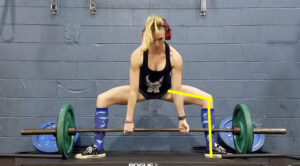
Differences in Squat and Deadlift Positions
For most people researching effective ways to build strength, they will have either read or been told about squatting and deadlifting. These are two of the fundamental and most effective compound movements for human beings to develop strength through. Within those however, there are differences in squat and deadlift positions that make some better choices than others based on your body type, biomechanical restrictions or training goals and we will introduce them here.
We will talk about common differences in squat and deadlift positions, and reasons for choosing a particular style of lift, but note that there are exceptions for every rule!

Back Squats: High Bar vs Low Bar
Placing the barbell on ones back and utilizing proper technique to squat down to full depth (or as close to full as one’s body will allow) define the back squat. A squat is considered full depth when the crease of the hips falls below the level of the knees and even though there a plenty of reasons for why a person may not have full depth available to them, attaining full depth should be a goal.

Some suggest that a low bar squat is notably more efficient in recruiting glute and hamstring musculature and is therefore superior but in actuality either variation, in conjunction with the proper programming can be used to achieve significant strength gains.

Front Squats
A front squat places the bar at the front of the shoulders and holding it there with a “front rack” arm position (elbow wrapped around the bar and facing forward, bar resting on anterior deltoids, cradled in the fingers). A front squat requires an entirely upright position of the trunk and by placing the load forward of the center of mass is fantastic for training quadriceps and the upper back musculature required to hold the bar up.
Due to the body’s ability to hold more weight on it’s back than it can on the shoulders, the back squat allows you to lift significantly more weight than the front squat. However, the front squat more closely resembles the motion of rising from the floor when catching a clean or a snatch and is therefore superior to training Olympic lifts.
There are an almost infinite number of variations and adjustments that a lifter can make to all of these movements based on their needs, body type and anthropometry (the dimensions and ratios of the different segments of the body). For instance if a lifter has a notably restricted thoracic spine or tightness through the shoulders and chest (as many of our desk worker clients do), a low bar squat bar position may not be accessible to them and they may have to at least start their training with a high bar.

Similarly with ankle mobility, if someone has restrictions through their ankle joints then a full depth squat may not be possible for them and utilizing a lift under the heels and a good prehab, joint mobilization protocol recommended by a trainer or physical therapist can help tremendously in achieving good lifting positions.

DeadLifts: Conventional vs Sumo
A deadlift is defined by utilizing proper form and technique to pick a loaded barbell off of the ground and bring it up to the waist. It is one of the best movements for building muscle, strength and athleticism. It is used by a large group of athletes and lifters as the strength it builds and movement it trains has wide application. For instance the deadlift comprises the first part of a power clean and is necessary to train by Olympic lifters. A proficient deadlifter needs proper hip hinge mechanics, mobility and raw strength, which are not only tested during the lift but also built up by it.
The two most common forms of the deadlift are the conventional and sumo positions.
The conventional deadlift will place your feet about shoulder width apart and your hands to the outside of your knees.

The sumo deadlift will place your feet as far apart as they can get comfortably with feet pointed out and places your hands towards the center of the bar, inside your knees.

Both of these will target the same groups of muscles (glutes, hamstrings, low back, quads, adductors) but will favor different groups based on position.
The conventional position requires a more bent over trunk and thus will test your hip hinge and low back stability more. This can be both a benefit and a detriment depending on your goals and deficits. The sumo deadlift is somewhat less stressful to the low back and can target the glutes more effectively but can also overstress the adductors.

Again, goals and body type are paramount in deciding which difference in squat and deadlift position is right for you and in truth a well designed program will utilize combinations of these lifts and others for optimal results.
Within the scope of lifting there are many things left to consider: equipment such as belts and lifting shoes, accessory lifts for general strength and specific weaknesses, the variety of rep schemes one can use for different purposes, etc. Coming to an experienced coach to figure out a program for you can push your training to new levels.
Gene Kopyt, MPT

This post was written by Gene Kopyt in May of 2021. Gene is an avid barbell lifter himself.
Learn more about Gene on our about page: https://gopt.co/about/